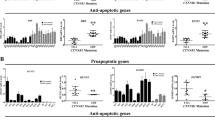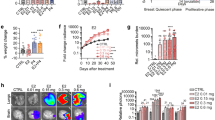Abstract
β-catenin, an oncogene, and P53, a tumor suppressor, are common targets of mutation in human cancers. It has been observed that P53 is often inactivated in tumors involving β-catenin activation. In an attempt to model this situation in vivo, we crossed the previously characterized MMTV-ΔN-β-catenin mouse with the P53 knockout mouse. Female multiparous mice that carry the MMTV-ΔN-β-catenin transgene and that are heterozygous for P53 (TgΔN-βCat/+, P53+/−) display an increased tumor burden (2.05 vs 1.31 tumors/animal), with a generally more advanced pathology, and increased metastatic rate (39 vs 0%) relative to transgenic female mice that are wild type for P53 (TgΔN-βCat/+, P53+/+). These differences were not due to complete loss of P53 as only one of 21 tumors demonstrated loss of heterozygosity at the P53 locus. Furthermore, no mutations were present in tumors retaining a single wild-type allele. TgΔN-βCat/+, P53−/− male mice developed testicular teratomas and survived an average of 65 days, whereas non-TgΔN-βCat, P53−/− males survived an average of 84 days. Sixty-two percent of TgΔN-βCat, P53−/− mice developed testicular teratomas, whereas only 10% of the non-TgΔN-βCat, P53−/− mice developed these tumors. These results indicate that the level of P53 and the tissue of origin are important factors in determining outcome of cancer caused by oncogene activation.
This is a preview of subscription content, access via your institution
Access options
Subscribe to this journal
Receive 50 print issues and online access
$259.00 per year
only $5.18 per issue
Buy this article
- Purchase on Springer Link
- Instant access to full article PDF
Prices may be subject to local taxes which are calculated during checkout





Similar content being viewed by others
References
Behrens J, Jerchow BA, Wurtele M, Grimm J, Asbrand C, Wirtz R et al. (1998). Science 280: 596–599.
Behrens J, von Kries JP, Kuhl M, Bruhn L, Wedlich D, Grosschedl R et al. (1996). Nature 382: 638–642.
Brennan KR, Brown AM . (2004). J Mammary Gland Biol Neoplasia 9: 119–131.
Brodie SG, Xu X, Li C, Kuo A, Leder P, Deng CX . (2001). Oncogene 20: 1445–1454.
Brunner E, Peter O, Schweizer L, Basler K . (1997). Nature 385: 829–833.
Chung GG, Zerkowski MP, Ocal IT, Dolled-Filhart M, Kang JY, Psyrri A et al. (2004). Cancer 100: 2084–2092.
Damalas A, Ben-Ze'ev A, Simcha I, Shtutman M, Leal JF, Zhurinsky J et al. (1999). Embo J 18: 3054–3063.
Damalas A, Kahan S, Shtutman M, Ben-Ze'ev A, Oren M . (2001). Embo J 20: 4912–4922.
Donehower LA, Godley LA, Aldaz CM, Pyle R, Shi YP, Pinkel D et al. (1995a). Genes Dev 9: 882–895.
Donehower LA, Harvey M, Slagle BL, McArthur MJ, Montgomery Jr CA, Butel JS et al. (1992). Nature 356: 215–221.
Donehower LA, Harvey M, Vogel H, McArthur MJ, Montgomery Jr CA, Park SH et al. (1995b). Mol Carcinog 14: 16–22.
Gunther EJ, Moody SE, Belka GK, Hahn KT, Innocent N, Dugan KD et al. (2003). Genes Dev 17: 488–501.
Hainaut P, Hernandez T, Robinson A, Rodriguez-Tome P, Flores T, Hollstein M et al. (1998). Nucleic Acids Res 26: 205–213.
Harris SL, Levine AJ . (2005). Oncogene 24: 2899–2908.
Harvey M, McArthur MJ, Montgomery Jr CA, Bradley A, Donehower LA . (1993). Faseb J 7: 938–943.
Hatsell S, Rowlands T, Hiremath M, Cowin P . (2003). J Mammary Gland Biol Neoplasia 8: 145–158.
He TC, Sparks AB, Rago C, Hermeking H, Zawel L, da Costa LT et al. (1998). Science 281: 1509–1512.
Henrard D, Ross SR . (1988). J Virol 62: 3046–3049.
Honecker F, Kersemaekers AM, Molier M, Van Weeren PC, Stoop H, De Krijger RR et al. (2004). J Pathol 204: 167–174.
Hundley JE, Koester SK, Troyer DA, Hilsenbeck SG, Subler MA, Windle JJ . (1997). Mol Cell Biol 17: 723–731.
Ikeda S, Kishida S, Yamamoto H, Murai H, Koyama S, Kikuchi A . (1998). Embo J 17: 1371–1384.
Imbert A, Eelkema R, Jordan S, Feiner H, Cowin P . (2001). J Cell Biol 153: 555–568.
Jones JM, Attardi L, Godley LA, Laucirica R, Medina D, Jacks T et al. (1997). Cell Growth Differ 8: 829–838.
Kielman MF, Rindapaa M, Gaspar C, van Poppel N, Breukel C, van Leeuwen S et al. (2002). Nat Genet 32: 594–605.
Kinzler KW, Vogelstein B . (1996). Cell 87: 159–170.
Kishida S, Yamamoto H, Ikeda S, Kishida M, Sakamoto I, Koyama S et al. (1998). J Biol Chem 273: 10823–10826.
Kozma S, Osterrieth PM, Francois C, Calberg-Bacq CM . (1980). J Gen Virol 51: 327–339.
Levina E, Oren M, Ben-Ze'ev A . (2004). Oncogene 23: 4444–4453.
Li Y, Welm B, Podsypanina K, Huang S, Chamorro M, Zhang X et al. (2003). Proc Natl Acad Sci USA 100: 15853–15858.
Lin SY, Xia W, Wang JC, Kwong KY, Spohn B, Wen Y et al. (2000). Proc Natl Acad Sci USA 97: 4262–4266.
Liu BY, McDermott SP, Khwaja SS, Alexander CM . (2004). Proc Natl Acad Sci USA 101: 4158–4163.
Liu J, Stevens J, Rote CA, Yost HJ, Hu Y, Neufeld KL et al. (2001). Mol Cell 7: 927–936.
Martin SS, Ridgeway AG, Pinkas J, Lu Y, Reginato MJ, Koh EY et al. (2004). Oncogene 23: 4641–4645.
Matsuzawa SI, Reed JC . (2001). Mol Cell 7: 915–926.
Michaelson JS, Leder P . (2001). Oncogene 20: 5093–5099.
Molenaar M, van de Wetering M, Oosterwegel M, Peterson-Maduro J, Godsave S, Korinek V et al. (1996). Cell 86: 391–399.
Polakis P . (2000). Genes Dev 14: 1837–1851.
Rodriguez I, Ody C, Araki K, Garcia I, Vassalli P . (1997). Embo J 16: 2262–2270.
Ryo A, Nakamura M, Wulf G, Liou YC, Lu KP . (2001). Nat Cell Biol 3: 793–801.
Sadot E, Geiger B, Oren M, Ben-Ze'ev A . (2001). Mol Cell Biol 21: 6768–6781.
Sato N, Meijer L, Skaltsounis L, Greengard P, Brivanlou AH . (2004). Nat Med 10: 55–63.
Schmitt CA, Fridman JS, Yang M, Baranov E, Hoffman RM, Lowe SW . (2002). Cancer Cell 1: 289–298.
Slee EA, O'Connor DJ, Lu X . (2004). Oncogene 23: 2809–2818.
Smalley MJ, Dale TC . (2001). J Mammary Gland Biol Neoplasia 6: 37–52.
Stevens LC . (1967). J Natl Cancer Inst 38: 549–552.
Stevens LC, Mackensen JA . (1961). J Natl Cancer Inst 27: 443–453.
Tetsu O, McCormick F . (1999). Nature 398: 422–426.
van de Wetering M, Cavallo R, Dooijes D, van Beest M, van Es J, Loureiro J et al. (1997). Cell 88: 789–799.
Venkatachalam S, Shi YP, Jones SN, Vogel H, Bradley A, Pinkel D et al. (1998). Embo J 17: 4657–4667.
Willert K, Brown JD, Danenberg E, Duncan AW, Weissman IL, Reya T et al. (2003). Nature 423: 448–452.
Yin Y, Stahl BC, DeWolf WC, Morgentaler A . (1998). Dev Biol 204: 165–171.
Acknowledgements
We thank Dr Lorelei Mucci for helpful discussions and advice related to our statistical analysis. We thank Dr Roderick Bronson for his technical expertise, helpful discussions and advice related to the pathology of the tumors. We would also like to thank Drs Jeff Ecsedy and Stuart Martin for critically reading the manuscript.
Author information
Authors and Affiliations
Corresponding author
Rights and permissions
About this article
Cite this article
Ridgeway, A., McMenamin, J. & Leder, P. P53 levels determine outcome during β-catenin tumor initiation and metastasis in the mammary gland and male germ cells. Oncogene 25, 3518–3527 (2006). https://doi.org/10.1038/sj.onc.1209391
Received:
Revised:
Accepted:
Published:
Issue Date:
DOI: https://doi.org/10.1038/sj.onc.1209391
Keywords
This article is cited by
-
p53 deficiency induces cancer stem cell pool expansion in a mouse model of triple-negative breast tumors
Oncogene (2017)
-
MicroRNA-Mediated Post-Transcriptional Regulation of Epithelial to Mesenchymal Transition in Cancer
Pathology & Oncology Research (2017)
-
Restin suppressed epithelial-mesenchymal transition and tumor metastasis in breast cancer cells through upregulating mir-200a/b expression via association with p73
Molecular Cancer (2015)
-
Key signaling nodes in mammary gland development and cancer: β-catenin
Breast Cancer Research (2010)



